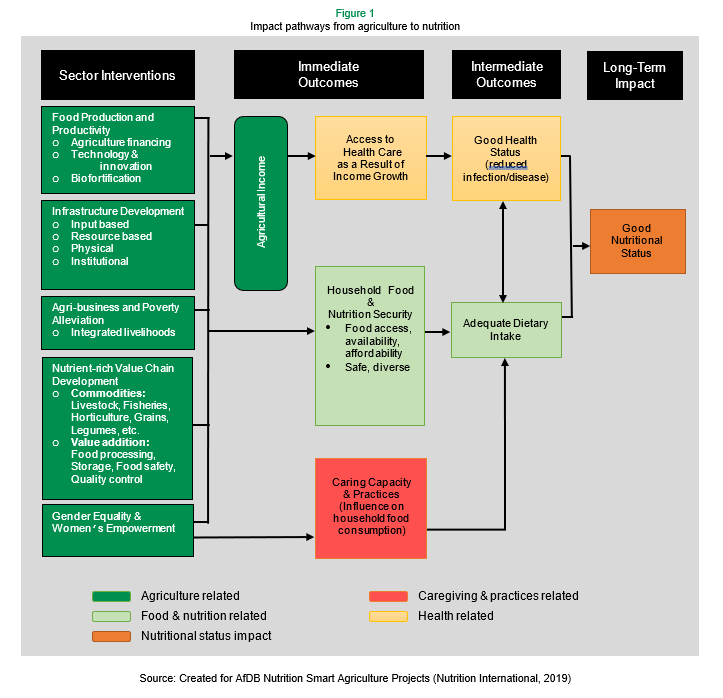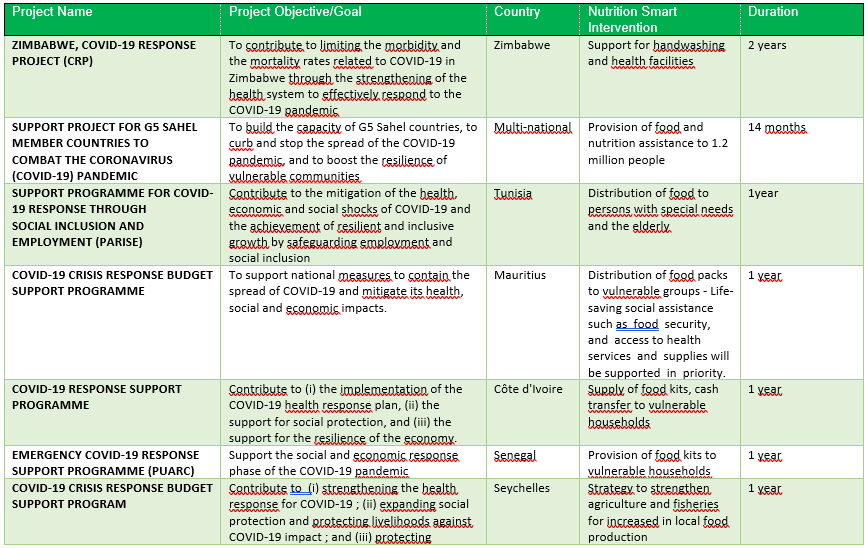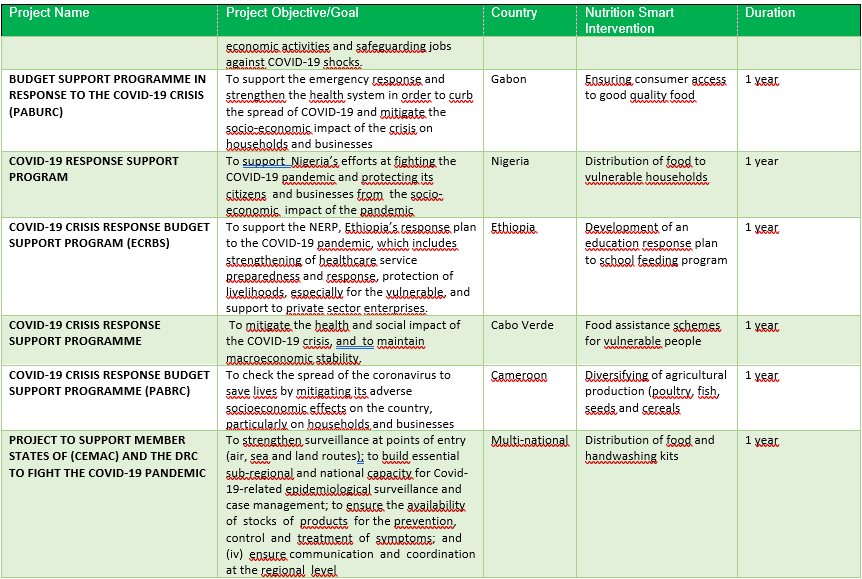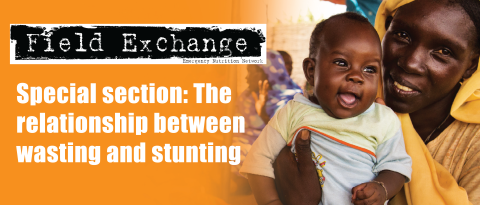Leveraging the ‘Banking on Nutrition’ partnership initiative in Africa
This article describes how an ongoing nutrition-smart programming approach was employed by the African Development Bank and harnessed as part of its COVID-19 response intervention.
Wisdom Dube is a Nutrition Consultant at Nutrition International providing technical assistance to support the African Development Bank’s multi-sectoral nutrition action plan and the COVID-19 related investments.
Babatunde Omilola leads the Division for Public Health, Nutrition and Social Protection of the African Development Bank.
Maimouna Diop Ly was formerly the Chief Health and Social Protection Officer of the African Development Bank.
Kefas Samson is the Director of the Nutrition Technical Assistance Mechanism (NTEAM) at Nutrition International.
Carol Broderick is the Portfolio Director of NTEAM at Nutrition International.
Marian Amaka Odenigbo is a Senior Advisor for Multisectoral Nutrition of the NTEAM at Nutrition International.
Location: Africa
Key messages:
- The Banking on Nutrition partnership initiative – conceived as a means of ensuring food and nutrition security, addressing stunting and to unlock Africa’s human potential – was effectively leveraged to tackle the pressing issues brought about by the COVID-19 pandemic.
- The COVID-19 pandemic has posed a significant threat to health and nutrition security at global, regional and national levels requiring emergency and sustained actions.
- Governments need to leverage the available resources to address the knock-on effects of the COVID-19 pandemic including nutrition-focused initiatives to safeguard public health and nutrition.
- Partnership engagement towards the operationalisation of multi-sector nutrition action plans is a critical driver for nutrition impact in Africa.
This paper was prepared with support from Nutrition International's Nutrition Technical Assistance Mechanism (NTEAM) under the Technical Assistance delivery to the African Development Bank and its Banking on Nutrition programme, funded by the Dangote Foundation and Big Win Philanthropy. The views provided here are those of the authors and do not necessarily reflect the official positions of the named organisations.
Introduction
The African Union has declared 2022 as ‘The Year of Nutrition’ necessitated by the need to preserve the gains in addressing malnutrition following the emergence of the COVID-19 pandemic that “exposed the economic vulnerability of African countries, as well as the weaknesses of the health and food systems” (African Union, 2022). The COVID-19 pandemic has posed a significant threat to global, regional and national nutrition security due to the paralysis of many sectors including economic, health, education and agriculture. The short-term impacts of COVID-19 include disruptions to the food environment, reducing both access to and consumption of safe, nutritious and affordable diets. Food supply chains are affected by movement restrictions, social distancing, non-essential business closures and partial and/or total lockdown measures. Consequently, all available evidence points towards a probable loss of past gains achieved on food and nutrition security. The 2021 State of Food Security and Nutrition in the World report (FAO, 2021) estimated that the increase of world hunger, from 8.4% in 2019 to 9.9% in 2020, was predominantly attributed to the COVID-19 pandemic. More than a third of the world’s undernourished population currently live in Africa (FAO, 2021). The long-term impact of the pandemic is projected to increase the prevalence of under- and overnutrition, making it even more challenging to achieve the Zero Hunger sustainable development goal (SDG) target by 2030 (Global Nutrition Report, 2021).
From an economic standpoint, the International Monetary Fund (2020) reported a downward trend in global economic prospects with emerging markets and developing countries anticipated to experience a protracted economic depression, exacerbating the 1.6% projected economic decline resulting from COVID-19 in 2020 and 2021. At the regional level, the forecasts of the African Development Bank (ADB/the Bank) indicate a fall in Africa’s gross domestic product, with subsequent economic development predicted to drop by USD22.1 – USD88.3 billion (ADB, 2020). These reported economic predictions have generated growing concerns on food and nutrition security, particularly as it relates to marginalised and nutritionally at-risk populations.
The ‘nutrition-smart’1investment approach was envisioned in the Bank’s Multi-Sectoral Nutrition Action Plan (MNAP 2018–2025), developed through the support of the Banking on Nutrition (BoN) partnership. Nutrition-smart interventions that reduce chronic undernutrition are excellent investments in development programmes; for a typical African country, every dollar invested in reducing chronic undernutrition in children yields a USD16 return (The Power of Nutrition, 2021). These interventions also demonstrate benefit-cost ratios of up to 21.6% (Alderman et al, 2017). This article describes how an ongoing nutrition-smart investments initiative, which prioritises nutrition as a means for economic and human capital development in the African continent, contributed to the Bank’s broader COVID-19 response.
The ‘Banking on Nutrition’ partnership initiative
In May 2016, the Bank’s President, Dr Akinwumi Adesina, launched the BoN partnership initiative with the support of two philanthropic organisations – Big Win Philanthropy and the Aliko Dangote Foundation – to facilitate the integration of nutrition in the Bank’s operations. Overall, the initiative was built on the President’s vision of unlocking the human capital and economic potential of the continent by investing in what he referred to as “Africa’s grey matter infrastructure”. The specific goal was to catalyse efforts of member countries towards a 40% stunting reduction target by 2025.
In the bid to realise this goal, the BoN initiative encompassed a three-part approach: 1) mainstreaming nutrition into the investment bank’s portfolio and pipeline, including regional and country strategies, lending programmes, non-lending programmes and other activities; 2) increasing the production and consumption of safe and nutritious foods; and 3) encouraging regional member countries to prioritise nutrition-smart lending requests and investments (ADB, 2021a).
Nutrition integration for nutrition-smart projects entails having one or more nutrition-related objectives/goals, a nutrition-related activity/intervention and a nutrition-related indicator at the outcome or impact level. Through the implementation of nutrition-smart projects, the Bank envisions achieving both socioeconomic returns and nutrition impact, thereby harnessing a double win for the Bank and its member countries (ADB, 2021a).
Nutrition integration within the different stages of the Bank’s project cycle (programming, project identification, project preparation, project appraisal, implementation and completion) involved the following four key approaches:
- Rapid nutrition situation analysis to identify and target groups that are at risk with respect to nutrition (i.e., the first 1,000 days of life, children under five years of age, pregnant and lactating women, adolescent girls and populations with a high stunting prevalence/burden). COVID-19 measures such as lockdowns, travel restrictions and social distancing have made these vulnerable groups more susceptible to a worsened nutrition situation since they can no longer access usual nutrition services.
- Integration of explicit nutrition objectives in the relevant project investment components at the onset of the project’s planning or design stage.
- Integration of cost effective, evidence-based nutrition activities, including multi-sector implementation actions.
- Articulation of nutrition causal impact pathways with an illustration of the potential contribution to nutritional outcomes in addition to overall project goals. The causal impact pathways provide an operational framework for setting relevant nutrition indicators to ensure that nutrition-smart interventions effectively address nutrition in the Bank’s projects.
A typical design and impact pathway for an agricultural development project illustrates the double win concept of the BoN nutrition-smart investing approach (Figure 1). On the one hand, the project interventions, which include crop productivity, poverty reduction actions, women’s empowerment, value chains and agribusiness development, have great potential for socioeconomic returns. On the other hand lies the immediate nutrition gains such as access to and the affordability of nutritious, safe food and access to health services and intermediate outcomes such as good health, reduced morbidity and adequate dietary intake.
Figure 1: Example of an impact pathway for the nutrition-smart agriculture projects

This impact pathway outlines a logical framework for achieving adequate nutritional status via agricultural sector interventions, providing a useful insight into how nutrition-smart projects can contribute towards immediate, intermediate and long-term nutrition outcomes.
Prior to the COVID-19 pandemic, the BoN partnership funded several nutrition smart projects within key sectors. Examples include a savannah zone agricultural productivity improvement project in Ghana, 2017 (agriculture sector), a project to support the East African Nutritional Sciences Institute in Burundi, 2019 (education sector), a climate-smart rural water, sanitation and hygiene (WASH) development project in The Gambia, 2018 (WASH sector), improving health access and systems-strengthening in Sudan, 2018 (health sector) and humanitarian emergency assistance to cyclone and flood victims in Somalia, 2018 (social protection sector).
The Bank’s nutrition-smart programming in the context of COVID-19 response
The Bank began implementing its COVID-19 response in March/April 2020 with the launch of a USD3 billion COVID-19 social bond fund alongside a COVID-19 response facility of USD10 billion for African governments and the private sector. These funding facilities were availed to assist African countries to address the challenges and impacts of the pandemic through development projects.
In addition, the Bank’s ongoing BoN partnership initiative, which had a long-term goal and focus on stunting reduction, was leveraged to supplement the Bank’s efforts on combating COVID-19 in Africa. Nutrition integration in the COVID-19 response involved programmes across the five key sectors already prioritised by the BoN that accounted for more than 30% of African governments’ expenditure, namely agriculture, education, health, social protection and WASH. The range of sector-focused interventions supported include strengthening the health system with a focus on nutritional care, the continuity of nutrition services and school feeding, food distribution targeting vulnerable groups, improved access to WASH facilities and supporting diversified agricultural production.
This ongoing initiative on nutrition-smart programming facilitated the Bank’s prompt integration of nutrition into its COVID-19 response projects within member countries. An example of early support was the project designed to support G5 Sahel member countries (Burkina Faso, Mali, Mauritania, Niger and Chad) to combat the COVID-19 pandemic, the overall goal of which was to build the capacity and resilience of these countries to mitigate and stop the spread of COVID-19. This project integrated the procurement of food and nutrition products for emergency food distribution to 10,000 households, especially women-headed households, across the five countries. The implementation period was 14 months (April 2020 to June 2021).
Additionally, nutrition objectives were incorporated into the design of several country budget support programmes during the early days/months of the global COVID-19 pandemic. Table 1 presents some examples of the nutrition-smart interventions among the Bank’s COVID-19 response projects implemented in African countries.
Table 1: Examples of nutrition-smart COVID-19 projects


Source: Project Report-The African Development Bank COVID-19 Response in Africa: Prioritizing Nutrition
Interim results of the Banking on Nutrition partnership initiative
According to the BoN progress report (2021), the Bank leveraged USD2.3 billion between 2015 and 2020 for the implementation of nutrition-smart projects in Africa. The proportion of nutrition-smart projects between 2015 and 2020 increased from 5% to 18%, and 21% of the project interventions focused on women and children. The full results and the impact of the BoN efforts towards contributing to stunting reduction in Africa are expected to be available at the end of the seven-year period of the Bank’s MNAP (2018–2025). This ambitious seven-year MNAP timeline is consistent with the United States Agency for International Development’s view of using a longer timeframe (e.g., more than five years) and the use of multiple interventions as an appropriate approach to address stunting (USAID Advancing Nutrition, 2020).
Another key result from the BoN partnership initiative was the development and release of a high-level decision-making Continental Nutrition Accountability Scorecard2 through the African Leaders for Nutrition platform. The Continental Nutrition Accountability Scorecard was designed to mobilise country-led efforts towards addressing stunting and attaining other nutrition targets.
The BoN initiative has set the Bank on a path to achieve a double win for member countries by harnessing both nutrition gains and socioeconomic returns from the project’s implementation. BoN partners engaged with Nutrition International through its Nutrition Technical Assistance Mechanism (NTEAM) to support the operation of the Bank’s MNAP. Customised technical assistance packages were developed through NTEAM to help the Bank realise its nutrition-smart investment targets. Through these packages, the NTEAM supported nutrition integration into COVID-19 response programmes as well as the Bank’s pipeline portfolio on economic growth and human development.
Challenges
The integration of nutrition into the Bank’s development programmes came with its own challenges such as the institutional capacity-building requirements to support nutrition integration during project design and implementation. Examples of these challenges include project team fatigue and apprehension of addressing multiple cross-cutting issues (i.e., gender, nutrition, climate change and youth) that were required to be considered and incorporated into a project. Also, there was limited understanding and appreciation of the minimal changes required in a project to make it nutrition-smart. In addition, the limited awareness about the Bank’s existing MNAP was a constraint to driving institutional capacity-strengthening on nutrition.
These challenges were overcome through:
- Demystifying the term ‘nutrition integration’ and conducting a practical exercise on how to design a nutrition-smart project during the Bank’s staff training workshops at the Bank’s regional hubs. The post-workshop evaluation showed that 100% of the participants at the Southern regional hub workshop noted that “integrating nutrition is feasible”.
- Organising a nutrition-sensitisation event at the Bank’s headquarters to create awareness of the MNAP and disseminate information on nutrition integration into the Bank’s portfolio.
- Developing integrated impact pathways for the five priority sectors to illustrate the theory of change and entry points for the Bank's traditional projects or programmes to become nutrition-smart. These five sector briefs and other nutrition guidance resources are publicly accessible.3
- Developing a nutrition marker and project checklist as a quick guide and reference tool for nutrition-smart programming. A tracking nutrition dashboard was also developed to monitor and report on the Bank’s MNAP performance targets.
Conclusion
This article highlights how a multilateral development bank can take the leadership for nutrition through partnership initiatives that support nutrition integration in human development and economic growth programmes. It also demonstrates that prompt contributions to health, pandemic and emergency response programmes can be made by a multilateral development bank. Most importantly, amidst the COVID-19 pandemic, the BoN was proactive to ensure continued nutrition prioritisation within COVID-19 response programmes. The BoN initiative is a unique example of a successful partnership engagement between a multilateral bank, donors and a nutrition technical assistance partner towards positive nutrition outcomes. The BoN progress report indicates positive evidence of a partnership that is working successfully to garner results for nutrition and economic growth while utilising a nutrition multi-sector action plan.
We encourage other stakeholders – multilateral banks, donors, governments, civil societies, non-governmental organisations and private stakeholders across sectors – to consider adopting this approach to facilitate nutrition gains towards the 2025 World Health Assembly and the 2030 SDG targets.
For more information, please contact Wisdom Dube at wisdom.dube@icloud.com or Marian Amaka Odenigbo at modenigbo@nutritionintl.org.
The African Development Bank’s nutrition resources can be found through Nutrition International’s learning centre, available at: https://afdb-nutritionintl.talentlms.com/index.
References
African Development Bank (2018) Multi-Sectoral Nutrition Action Plan 2018-2025. African Development Bank https://www.afdb.org/fileadmin/uploads/afdb/Documents/Generic-Documents/Banking_on_Nutrition_ActionPlan_A4_V1d_single.pdf
African Development Bank (2020) African development bank group unveils $10 billion response facility to curb COVID-19 press release. https://www.afdb.org/en/news-and-events/press-releases/african-development-bank-group-unveils-10-billion-response-facility-curb-covid-19-35174.
African Development Bank (2021) The banking on nutrition partnership progress report 2015 – 2020: Investing in grey matter infrastructure with $2.3 billion in nutrition-smart project. African Development Bank https://www.afdb.org/en/documents/banking-nutrition-partnership-progress-report-2015-2020
Alderman, H, Behrman, JR and Hoddinott, J (2007) Economic and nutritional analyses offer substantial synergies for understanding human nutrition. The Journal of Nutrition, 137(3), 537–544.
African Union (2022) 2022: The Year of Nutrition. Accessed at https://au.int/en/theme/2022/year-nutrition
FAO (2002) The State of Food Insecurity in the World 2001. Rome.
FAO, IFAD, UNICEF, WFP and WHO (2021) The state of food security and nutrition in the world 2021. Fao.org
Global Nutrition Report (2020) 2020 Global Nutrition Report: Action on equity to end malnutrition. www.globalnutritionreport.org
IMF (2020) Regional economic outlook. Sub-Saharan Africa: COVID-19: an unprecedented threat to development, Washington, DC: International Monetary Fund.
USAID Advancing Nutrition (2020) Stunting: Considerations for Use as an Indicator in Nutrition Projects. Arlington, VA: USAID Advancing Nutrition. https://www.advancingnutrition.org/sites/default/files/2021-10/usaid_an_stunting_literature_review_2021.pdf
The Power of Nutrition (2021) Why Nutrition? Powerofnutrition.org. https://www.powerofnutrition.org/why-nutrition/
1 Nutrition-smart African Development Bank’s projects are those that are grounded in the five focus sectors of health, agriculture, water, sanitation and hygiene (WASH), social protection, and education.
2 More information about the CNAS can be found at https://www.afdb.org/fileadmin/uploads/afdb/Documents/Generic-Documents/Continental_Nutrition_Accountability_Scorecard-EN.pdf


 English
English Français
Français Deutsch
Deutsch Italiano
Italiano Español
Español